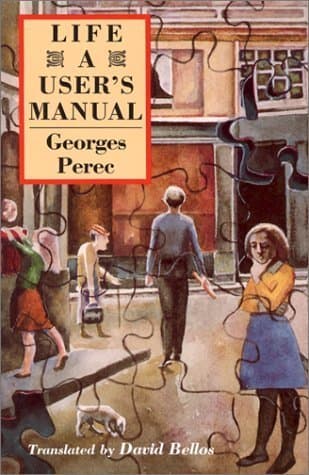
Book Review Summary: Life: A User's Manual
Introduction
Life: A User's Manual is a sprawling compendium of fictional stories, each interconnected within the framework of an apartment block in Paris. Written by Georges Perec, this novel is an extraordinary range of narratives that explore the human experience, showcasing the mixed fortunes, passions, and despairs of hundreds of lives. With its innovative structure and literary puzzles, this book offers a manual of human irony and a celebration of the ephemera that gives meaning to our lives.
About Georges Perec
Georges Perec was a highly-regarded French novelist, filmmaker, and essayist known for his experimental writing style and wordplay. Born in a working-class district of Paris, Perec was a member of the Oulipo group, a literary movement that emphasizes constraint and wordplay. His novels often feature lists, constraints, and attempts at classification, reflecting his fascination with the minutiae of life. Perec's works are tinged with melancholy and explore themes such as memory, identity, and the passage of time. He was also known for his dedication to archiving and preserving historical artifacts.
Analysis of Views
-
A Masterpiece of Experimental Writing: Many readers praise Life: A User's Manual for its experimental nature, describing it as an extraordinary range of fictions that push the boundaries of traditional storytelling. The book's innovative structure and literary puzzles, such as acrostics, crosswords, and mathematical formulae, add depth and engagement to the narratives.
-
A Celebration of Human Ephemera: The novel is also celebrated for its celebration of the ephemera that shapes our lives. Readers appreciate how Perec gives equal importance to possessions, ephemera, and clutter, highlighting the significance they hold for individuals. The book encourages readers to appreciate the small details that make up our lives.
-
A Tribute to Human Diversity: Life: A User's Manual showcases the diversity of human experiences, presenting a wide range of characters from different backgrounds and professions. Readers appreciate how Perec captures the nuances of human relationships, exploring themes such as love, loss, ambition, and identity. The book offers a rich tapestry of human stories that resonates with readers.
-
A Testimony to Human Irony: The novel is often described as a manual of human irony, portraying the mixed marriages of fortunes, passions, and despairs. Readers appreciate how Perec uses humor and wit to explore the absurdities and contradictions of life. The book's exploration of human irony adds depth and complexity to the narratives.
-
A Testament to Perec's Literary Skill: Many readers praise Georges Perec's literary skill, admiring his ability to weave together a vast array of stories within a single structure. The book's intricate plotting and meticulous attention to detail demonstrate Perec's talent as a storyteller. Readers appreciate how he creates a sense of cohesion despite the diverse range of narratives.
Reasons for Recommendation
-
Innovative Structure and Literary Puzzles: Life: A User's Manual offers an innovative structure that keeps readers engaged throughout the book. The incorporation of literary puzzles and puzzles adds depth and intrigue to the narratives, making it an enjoyable reading experience.
-
Celebration of Human Ephemera: The book's celebration of human ephemera resonates with readers who appreciate the significance of possessions and the details that shape our lives. The exploration of human relationships and experiences through possessions adds depth to the narratives and offers a unique perspective on life.
-
Diversity of Characters: The wide range of characters presented in Life: A User's Manual appeals to readers who appreciate diversity in literature. The exploration of different backgrounds and professions allows readers to connect with various characters and gain insights into different aspects of human life.
-
Humor and Irony: The book's humor and irony add levity to the narratives, making it an enjoyable read despite its serious themes. Readers appreciate how Perec uses wit and humor to explore the absurdities and contradictions of life, providing moments of levity amidst the challenges faced by his characters.
Reasons for Not Recommendation
-
Lack of Connectedness: Some readers find that the multiple narratives in Life: A User's Manual lack cohesion or a clear overarching narrative. They feel that the book lacks a strong sense of direction or purpose, making it challenging to follow at times.
-
Challenging Structure: The book's experimental structure may be challenging for some readers who prefer more traditional storytelling techniques. The incorporation of literary puzzles and puzzles may require additional effort from readers to fully engage with the narratives.
Conclusion
Life: A User's Manual by Georges Perec is a masterpiece that defies conventional storytelling norms with its innovative structure and exploration of human ephemera. The novel offers a celebration of human diversity through its wide range of characters and showcases human irony through its humorous and poignant narratives. While some readers find the lack of cohesion or traditional narrative structure challenging, others appreciate the book's unique approach to storytelling and its ability to engage readers through literary puzzles and wordplay. Overall, Life: A User's Manual is a highly recommended read for those seeking an unconventional exploration of human experiences and the significance of possessions in shaping our lives.